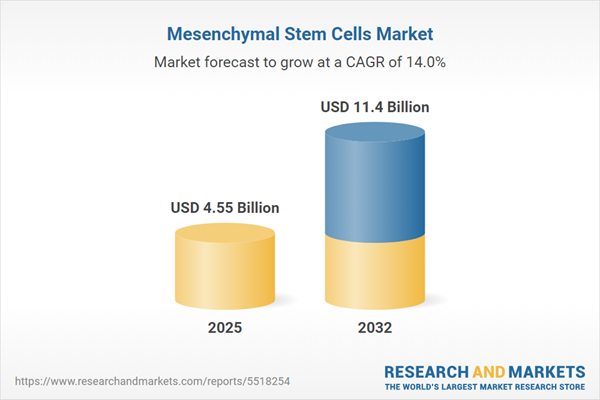Speak directly to the analyst to clarify any post sales queries you may have.
The mesenchymal stem cells market is undergoing swift transformation as new clinical applications, regulatory adjustments, and technology advancements reshape the competitive environment. Senior decision-makers must navigate shifting opportunities while managing compliance and operational complexity to sustain growth and strategic focus.
Market Snapshot: Mesenchymal Stem Cells Market Outlook
The mesenchymal stem cells market is valued at USD 3.98 billion in 2024 and is projected to reach USD 4.55 billion in 2025, with forecasted growth to USD 11.40 billion by 2032 and a compound annual growth rate (CAGR) of 14.02%.
Market momentum is bolstered by innovations in cell culture technology, enhanced industry investment, and a regulatory landscape that continues to evolve. Strategic market leaders are prioritizing scalable manufacturing, efficient logistics, and seamless clinical integration to reinforce compliance practices. Competitive differentiation and regional market expansion remain top priorities, enabling organizations to maintain a strong position as industry standards progress.Scope & Segmentation: Strategic Framework for Decision-Makers
This comprehensive analysis gives senior leaders precise segmentation for future planning and informed strategy. Each segment supports targeted investment, operational alignment, and risk management as the sector grows:
- Applications: Focus areas include autoimmune, cardiovascular, neurological, diabetes, orthopedic, regenerative, and wound healing therapies, each driving research collaborations and cross-functional innovation potential.
- Sources: Reliable sourcing from adipose tissue, bone marrow, dental pulp, placenta, and umbilical cord enables organizations to maintain supply chain strength and adapt to emerging clinical trends.
- End Users: Engagement strategies must be designed for hospitals, research institutes, biobanks, contract manufacturers, pharmaceutical companies, and biotechnology firms to enable effective commercialization and partnership models.
- Product Types: Instrumentation, assay kits, reagents, dissociation agents, growth factors, culture media, supplements, surface markers, antibodies, and specialist services offer multiple avenues for product portfolio development, solution differentiation, and recurring revenues.
- Culture Methods: Adoption of fixed-bed, hollow-fiber, and stirred tank bioreactors, alongside two- and three-dimensional systems such as hydrogels, scaffolds, and spheroids, delivers flexibility and scalability in alignment with both clinical and research goals.
- Therapy Types: Allogeneic and autologous approaches require distinct regulatory and logistics pathways, allowing organizations to respond to patient needs and changing compliance environments.
- Regions: Strategic focus on the Americas, Europe, Middle East, Africa, and Asia-Pacific facilitates market entry planning, partnership optimization, and navigation of region-specific regulatory conditions.
- Key Companies: Market dynamics are shaped by active players including Mesoblast Limited, Pluristem Therapeutics Inc., Athersys, Inc., Lonza Group AG, STEMCELL Technologies Inc., Cellular Biomedicine Group, Cynata Therapeutics Limited, Anterogen Co., Ltd., Vericel Corporation, and SanBio Co., Ltd.
Key Takeaways for Senior Decision-Makers
- Streamlined manufacturing processes and robust logistics models are empowering organizations to expand operational capacity and improve efficiency in regenerative medicine.
- Emerging therapies and evolving clinical integration pathways increase the complexity of the supply chain, requiring nimble infrastructure and strategic adaptability for continued development.
- The use of advanced bioreactors and three-dimensional cell culture methods continues to set industry benchmarks for cell quality control and reproducibility, ensuring reliable outcomes.
- Strategic alliances with research and biotechnology partners drive faster technology adoption, reinforce supply chain stability, and facilitate expertise sharing.
- Localized sourcing strategies and adaptable manufacturing operations are supporting risk management and operational continuity amid changing regulatory or geopolitical events.
- Growing interest in cell-free therapeutic modalities, such as secretome and vesicle-based solutions, promotes portfolio diversification while aligning with evolving market and regulatory requirements.
Tariff Impact on Supply Chain and Manufacturing
New U.S. tariffs targeting reagents and equipment are prompting companies to increase domestic manufacturing, enhance vertical integration, and update procurement practices. These actions improve resilience and reduce exposure to policy changes, helping businesses maintain operational flow in a dynamic environment.
Methodology & Data Sources
This study utilizes insights from industry executives, regulatory specialists, and cell therapy experts. Findings are corroborated by current research literature, patent reviews, official regulatory documents, and authoritative industry white papers, delivering evidence-based insights to guide strategic decision-making.
Mesenchymal Stem Cells Market: Why This Report Matters
- Enables executive teams to anticipate shifts in the mesenchymal stem cells market and prepare agile strategies for future developments.
- Offers clear segmentation and regional analysis, supporting enhanced risk evaluation and operational alignment at scale.
- Equips organizations with actionable guidance to address ongoing tariff, regulatory, and commercial shifts, building resilience and supporting value creation.
Conclusion
This analysis provides senior leaders with the strategic framework needed to address evolving regulatory demands, capitalize on new opportunities, and maintain sustained value across the regenerative medicine sector.
Additional Product Information:
- Purchase of this report includes 1 year online access with quarterly updates.
- This report can be updated on request. Please contact our Customer Experience team using the Ask a Question widget on our website.
Table of Contents
3. Executive Summary
4. Market Overview
7. Cumulative Impact of Artificial Intelligence 2025
Companies Mentioned
The companies profiled in this Mesenchymal Stem Cells market report include:- Mesoblast Limited
- Pluristem Therapeutics Inc.
- Athersys, Inc.
- Lonza Group AG
- STEMCELL Technologies Inc.
- Cellular Biomedicine Group, Inc.
- Cynata Therapeutics Limited
- Anterogen Co., Ltd.
- Vericel Corporation
- SanBio Co., Ltd.
Table Information
| Report Attribute | Details |
|---|---|
| No. of Pages | 182 |
| Published | October 2025 |
| Forecast Period | 2025 - 2032 |
| Estimated Market Value ( USD | $ 4.55 Billion |
| Forecasted Market Value ( USD | $ 11.4 Billion |
| Compound Annual Growth Rate | 14.0% |
| Regions Covered | Global |
| No. of Companies Mentioned | 11 |









